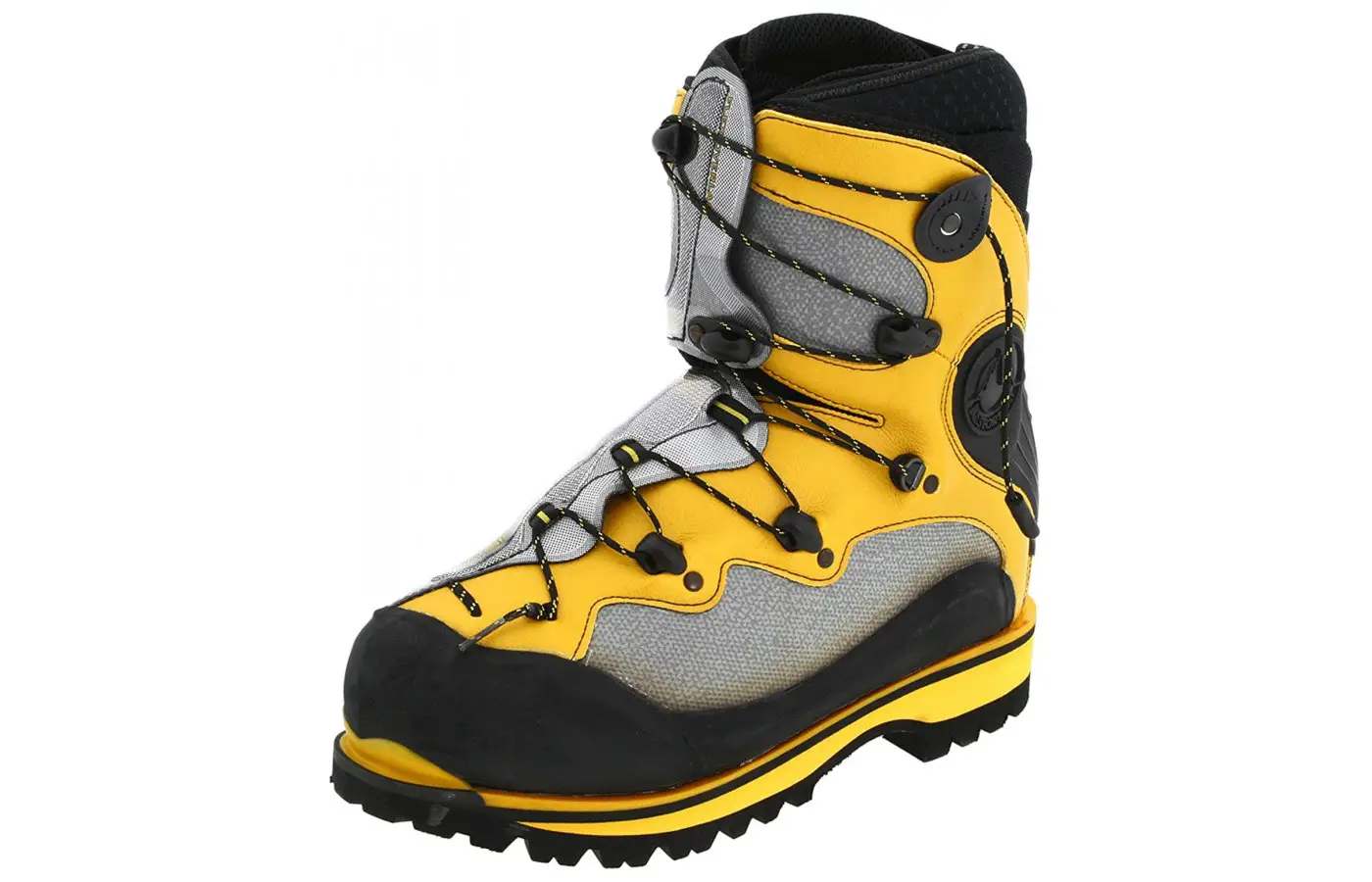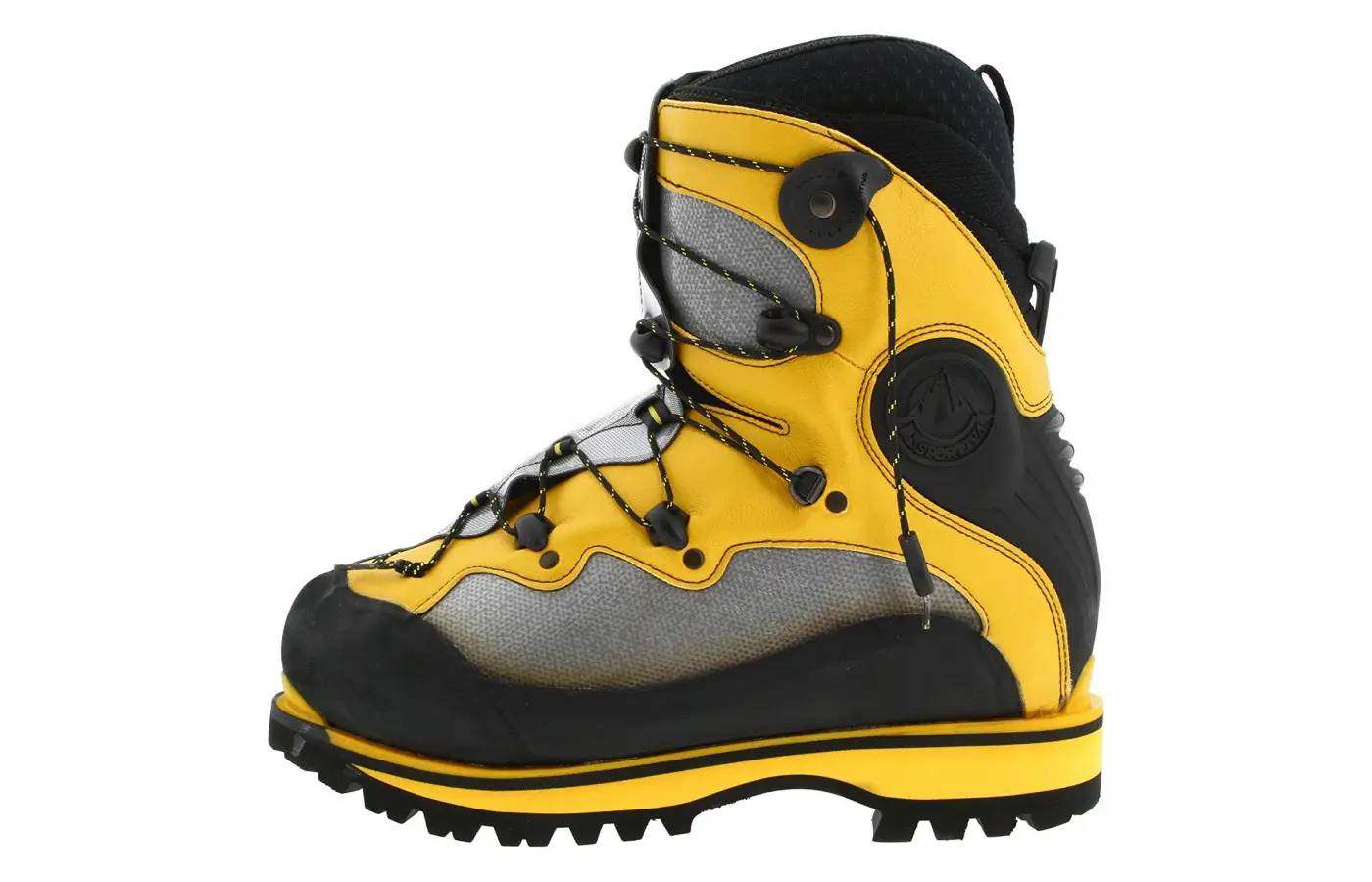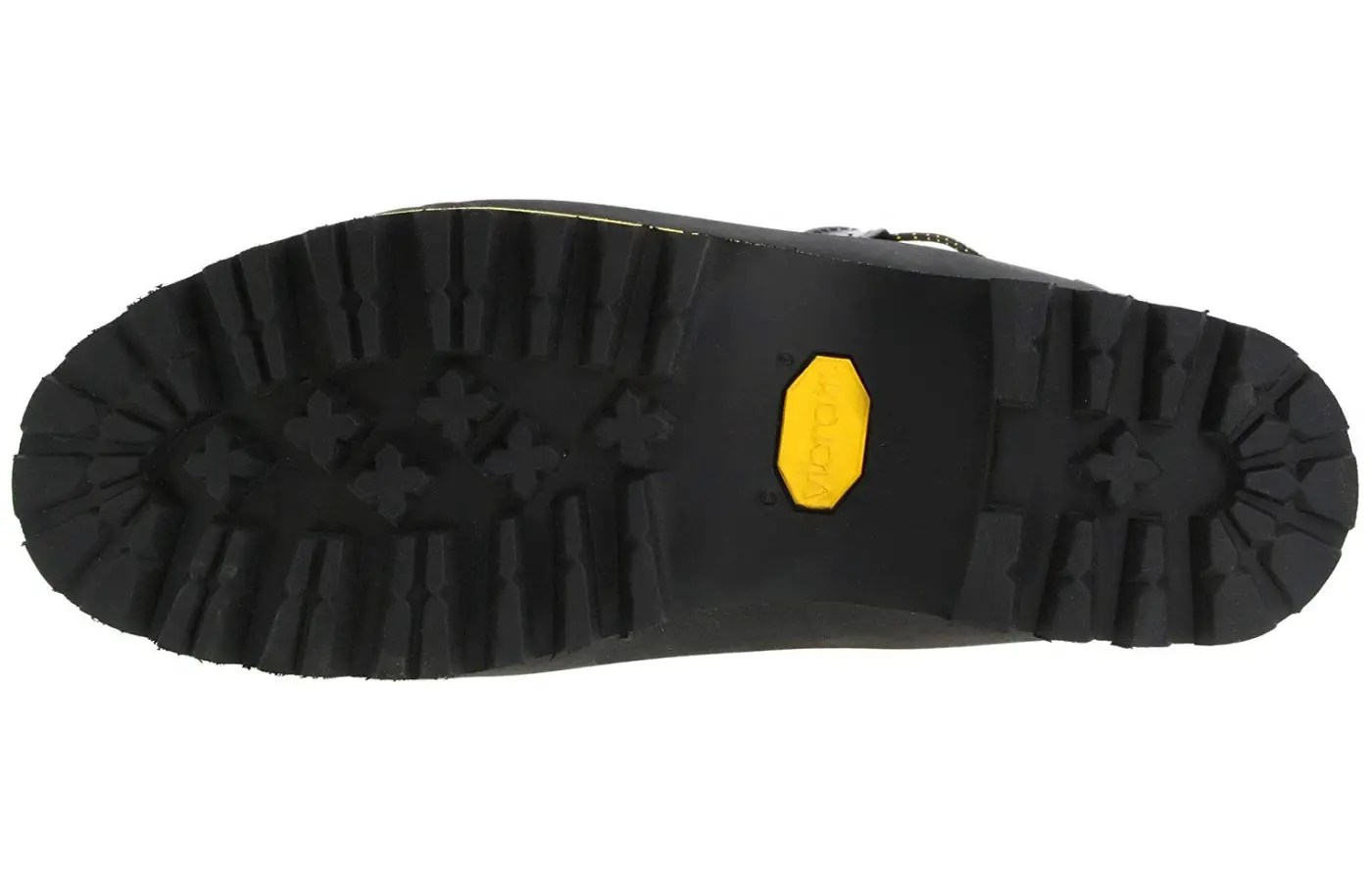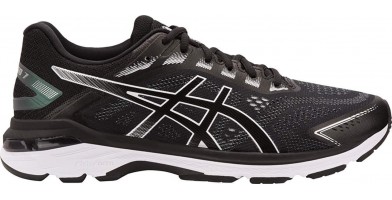La Sportiva Spantik Review Facts
The terrific challenge of climbing high altitude mountains has long inspired wonderment and exhilaration. People, in an attempt to find supreme greatness within themselves, have sought to endure the unforgiving forces of nature. Many have suffered and died to find their place upon the highest frontiers of the world--not for bragging rights, but for serene fulfillment. With advancements in technology, more people have been able to quench the thirst of mountaineering as a life goal. One such advancement is the quintessential mountaineer’s boot. Over the years, high altitude climbing boots have advanced their capabilities to places once never thought possible. Yet, all these complex advancements center on just a few basic needs: Protection, warmth, and stability. Protection against lacerations, warmth against the biting cold, and stability against falls and broken limbs.
Climbing technology has never been a crutch to make your accent any easier. Any innovation in the technology merely evens the odds against the uncontrollable elements. The true challenge is one that tests our endurance and resilience despite chance or luck. The La Sportiva Spantik will satisfy all these basic needs, so you can endure the trials of a climb with focus on what you can control. You will rarely find any other boot that functions as well as these on technical terrain while still keeping you safe and warm at six-thousand meter plus elevations.
Double Boot System
The Spantik incorporates a double boot system. A double boost system has two essential benefits for the wearer. The space and layering between the inner boot and outer shell creates
excellent insulation. Second, you can easily dry the removable inner boot in your sleeping bag during multiple day excursions. This double boot is narrow compared with others, so while fitting can be an issue, it performs better than most on technical ground.
Outer Boot
The outer shell is made up of five different layers, two of which are composed of Polyethylene closed-cell foam (the shells main material for insulation). Much of the top most layer is a leatherette material that appears a lot like leather but is less breathable and more waterproof. The foam is lined with heat-reflecting aluminum that takes in light-energy and filters its warmth into the boot’s interior. A thick upper maintains the hardy stiffness that you expect from a large double plastic boot without much of the discomfort when walking on level ground. The ankle backstay (achilles area) is reinforced with a thick plastic that supports the boots fit with crampons or
ski bindings.
Inner Boot
The inner boot is lightweight and has a sturdy enough sole to walk with around camp. They easily dry overnight once you pull them out and tuck them
someplace warm. The inner boot is composed of a mesh material that lays over its open-cell foam, so there is no need for a detachable foot liner. Also, the insole pops right out and be replaced with something more comfortable/fitting.The foam is thermo-moldable which means that heat controls your fit by causing the material to hug the shape of your feet.
Outsole
This thick outsole and deep lugs of this boot adds a little extra weight compared with its competitors, but in turn will provide you with increased durability. The outsole also features a braking system--basically a deeply curved indentation between the heel and the forefoot that wedges against the ground during steep descents. The wedged heel helps dig into the snow with the crampon, giving them good stopping power.
Terrain & Traction
These double boots are insulated and rugged enough for six to seven thousand meter peaks. They are a popular choice for climbing Mt. Rainier, Denali, and the ranges in Alaska. These high altitude terrains often include lengthy base camp approaches. The approaches usually require a second set of lighter boots with a flexible sole, so you don’t wear out your feet on flat terrain before the climb. One of the Spantiks most promising features are their foot rocking capability that keeps you from having to drag along a lighter pair. So, the sole of these boots maintains the rigidity
and protection necessary for steep climbs, while the generous foot rocker (U-shaped outsole) lets you roll your foot forward naturally, saving your assent from early burt-out feet.
Unlike bulky double plastic boots, this shoe’s leather material allows you to get a better sense of the terrain underfoot. They give you enough warmth without sacrificing the necessary control for a variety of activities. Buyers report using them on 60 degree glacial inclines, ice climbing, snowshoeing, and high elevation hikes.
Insulation
This boot is unique from other double boots because both its inner liner and outer shell is insulated. Its heat retention technologies, coupled with ample layering makes the Spantik a very warm boot for its weight. As previously mentioned, the outer shell has five unique layers of insulation. In addition, you have the space between the shell and the liner along with the layers of the lining boot itself, all working together for maximum protection.
Size and Weight
At five pounds total weight, the Spantik is one of the lightest double boots available. It maintains the insulation and rigidity of a high altitude double boot without its clunky and cumbersome qualities. It is also more comfortable overall when walking on flat terrain.
Buyers recommend buying one-half to one size up for men. It is generally recommended to try these boots on in different sizes before buying If you get a chance. By sizing up, you let your toes have the wriggle room needed to generate warmth more effectively; this warmth will in turn help the inner foam mold to your foot.
Unfortunately, there are very few top-tier mountaineering boots that are fitted for women and even fewer that come in women’s sizes. But despite the climbing footwear companies lack of recognition for female climbers, the Spantik has a general design that might still fit your feet. One female user reported that the thermal molding and narrow design of this boot makes it the best option available for women (assuming, of course, it comes in a size comparable to your own).
Airflow and Waterproofing
At high elevation external moisture isn’t as much of a threat to the warmth of your boots as compared with internal
sweating. The internal layering of a boot is unprotected by the hard shell from the inside, and if left wet will negate the boots insulation system. Regardless, these boots are waterproof just to be on the safe side. Both the inner and outer boot are coated with Antiacqua™ and water repellent Lorica®. As mentioned, the outer shell of this boot is made of a dense leatherette material that will keep out precipitation. The waterproofing of the inner boot and its decently sized sole will allow you to walk
around your camp ground before it’s dried overnight in a sleeping bag.
Comfort & Cushioning
The Spantiks maintaining their comfort and warmth whether you’re clinging to the ice of a slope or skiing along a level glacier. The double boot system keeps friction between the liner and the outer shell as opposed to with your foot and the insole. There plenty of padding throughout the ankle and forefoot for support and its EVA foam midsole provides excellent shock absorption.
The profile of the boot is narrow compared with some of the double plastic models. This narrowness allows for a better, more flexible handle on technical terrain but may be less friendly for wider fitting due to its lack of bulk. Make sure these boots are a good fit for you before taking them on any excursions.
The comfortability of a boot is never more important than when you’re high up on the slope of a mountain. You are quite literally stuck with whatever you decide to wear up there because there is no blister painful enough to lose your toes to
frostbite over. So, if you choose a boot with an uncomfortable fit, you’ll have to exacerbate their discomfort by using them to escape back down.
Flexibility
There is only so much flexibility a double boot with a shank is designed to have. A shank, if you don’t already know, is a long piece of steel that runs along the bottom sole of the shoe. Its purpose is to keep the bottoms of your feet safe from sharp, rock-hard glacial surfaces. While the shank protects your underfoot is also helps support your foot during vertical climbing. But, as you can imagine, a steel plank lining the bottom of your boot doesn’t make for a very flexible sole. This boot compensates for its rigidity with a curved outsole. So, while the sole doesn’t actually bend with the bend of your foot, it does allow you to rock forwards from heel-to-ball.
Support & Balance
As was said before, this boot is best known for striking a good balance between heel-to-toe transitioning while still being protective enough against puncture. They are not light or agile enough for summer climbing but are not nearly as bulky as double plastic boots. The double boot feature has the added benefit of two seperate sets of laces. The the double lacing system and beefy ankle support is essential for keeping the boot 90 degrees during vertical accents.
Lacing System
The outer boot has a no-tie one handed lacing system. The lace cord runs criss cross along one side of the upper, locks once on a rivet at the ankle, and is then wrapped and locked securely around a rivet at the top. Great for lacing your boots up while wearing gloves (as long as they aren’t too thick) so you don’t have as much exposure to the biting cold. The inner boot has a similar lacing system that binds to velcro at the top.
Value & Cost
The boot has an average price compared to other technical alpine climbers. But if you are new to mountaineering, your jaw might drop at the seven-hundred fifty dollar price tag. This is a boot that you invest in after much deliberation, research, and experience with mountain climbing. Just like you don’t jump from street jogging to high elevation climbing before working your way up, you don’t jump into these without some
experience with high elevation footwear. As more experienced climbers point out, the price tag doesn’t seem so off-putting when you divide it by how many toes you’ll save from frostbite.
Comparison & Similarities
Due to their similar price range, often times the Scarpa Phantom 6000 is reviewed as one of this boots main competitors. However, the Phantoms lack of a toe rocker leads climbers toward the Spantiks greater versatility and comfortability during lengthy approaches. The Phantom 6000’s are, however, just over one pound lighter than the Spantiks--which is a significant amount when every ounce you carry must be essential to your survival. In terms of fitting, the Phantoms are a bit wider and do not come in half sizes.
Key Features
Boot shell and Boot liner coated with Antiacqua™ and water repellent Lorica®
Generous foot rocker for base camp approaches
A heat absorbing aluminum outer layer that transfers heat to the insole of the boot
A heat reactive foam liner that hugs and supports the fit of your feet
Final Thoughts
The La Sportiva Spantik is exceptionally nimble for a high elevation alpine mountaineering boot. It affords the climber enough support for icy glacial regions, while its leathery shell gives greater precision on technical ground. Its curved toe-rocker allows you to walk on flat ground comfortably, so you won’t need to drag along an additional more flexible pair of boots on your hike to basecamp. These boots possess numerous forms of thermal technology suitable enough for six-thousand plus meter accents and continue to be a popular choice on monstrous peaks like Denali and Rainier. Overall, these boots are a great investment if you are serious about turning up the elevation of your climbs.
















